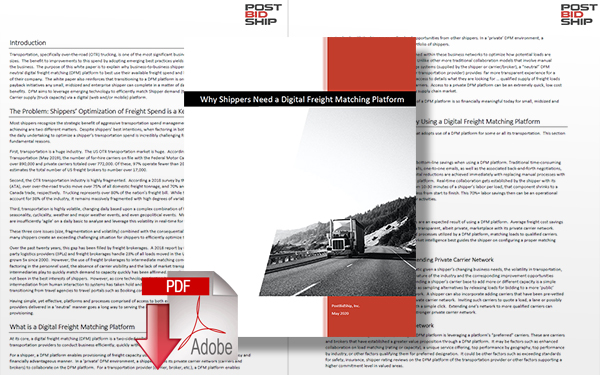Optimizing Digital Freight Matching Platforms: Posting Lead Times to Maximize Spot Market Response

In this best practices article we examine posting lead times, that is, the number of days in advance of a spot market shipment’s pickup date, for maximizing bid count.
Best Practices for Optimizing Your Digital Freight Matching Platform: Posting Lead Times for Maximizing Spot Market Response
Shippers often ask PostBidShip, “How far in advance of the pickup date should I post a load?”
In this first in a series of “Best Practices for Optimizing Your Digital Freight Matching (DFM) Platform,” we examine posting lead times, that is, the number of days in advance of a spot market shipment’s pickup date, for maximizing bid count.
Most Shippers Fail to Optimize Spot Bid Count
In this era of tight capacity and rising freight rates, it is especially important for shippers using a Digital Freight Matching Platform (DFM) to maximize their bid count and receive the most competitive price possible given today’s market conditions.
Unfortunately, many shippers fail to maximize their bid count by not allowing enough lead time ahead of the shipment’s pickup date.
PostBidShip research shows the most common (42%) lead time to be one business day before the shipment’s scheduled pickup date, with the next most common lead time (22%) being zero days (posted the same day as scheduled pickup date).
While DFM platforms produce bids with zero days’ lead time, shippers see a 27% improvement in bid count by allowing even one day’s lead time.
However, the largest jump in bid count occurs between one- and two-day lead times, and for the 64% of shipments posted with less than two days’ lead time, they may be missing out on better-priced bids.
Modest Lead Time Improvements Yield Major Results
When allowing two days’ lead time, shippers experience a 104% increase in bid count compared to one days’ lead time, and they see a whopping 160% increase in bid count when allowing two days’ lead time compared to zero days’ (same day) lead time.
Additional Few Days’ Lead Time Yield Marginal Benefits
Beyond two days’ lead time, the next few days’ lead time yield marginal improvements in bid count.
For example, an increase in lead time from two to four days results in a 9% increase in bid count.
A further increase in lead time from four to six days results in a 3% increase in bid count.
Bid Counts Decline After Six Days’ Lead Time
Bid counts peak when posting the shipment to the DFM platform with six days’ lead time.
Bid counts fall beginning on the seventh day and shippers experience a 31% decline in bid count between six days’ lead time and eight days’ lead time.
Bid counts continue to decrease beyond eight days as it becomes less certain where carriers’ equipment will be further into the future.
Recommendations
The late-notice or unexpected nature of spot market shipments may make it difficult for most shippers to post shipments six days ahead of the scheduled pickup date.
Whenever possible, we strongly recommend posting shipments at least two days prior to the scheduled pickup date.
Further, even when more than two days’ lead time is possible, we advise shippers that if they receive a bid they like after two days, they may wish to consider awarding it to secure the capacity.
The risk of losing a good bid in today’s capacity-constrained freight market likely weighs more heavily than the marginal increase in bid count that comes with an extra few days’ lead time.
To learn more about how PostBidShip’s Digital Freight Matching Platform can help you optimize your spot market freight bidding Contact Us Now.
About PostBidShip
PostBidShip is a neutral digital freight matching (DFM) platform that replaces outdated workflows with quick, cost-effective, and efficient matching of loads to transportation capacity in real-time, using near-time data analytics, market indices modeling and real-time digital collaboration, benefiting both parties through an optimal mix of cost, performance, convenience and asset utilization.
Related: Optimizing Digital Freight Matching: Maximizing Efficiency Through Transparent Freight Auctions
Related Papers
Why CARRIERS Need a Digital Freight Matching Platform
This white paper explains why business-to-business carriers today benefit from access to a neutral digital freight matching platform to best use their available capacity, resources, and equipment. Download Now!
Why SHIPPERS Need a Digital Freight Matching Platform
This white paper explains why business-to-business shippers today benefit from access to a neutral digital freight matching platform to best use their available freight spend and human capital resources on behalf of their company. Download Now!
More PostBidShip Resources
Article Topics
PostBidShip News & Resources
2021 Truckload Freight Market Trends and Proactive Steps Shippers Can Take Optimizing Your Digital Freight Matching Platform: Selecting Private or Public Bidding Best Practices for Optimizing Your Digital Freight Matching Platform Leveraging Carrier and Shipper Feedback to Improve the Digital Freight Matching Experience Optimizing Digital Freight Matching: Maximizing Efficiency Through Transparent Freight Auctions Optimizing Digital Freight Matching Platforms: Posting Lead Times to Maximize Spot Market Response Expanding Visibility, Operating Efficiency, and Market Intelligence for Shippers & Carriers More PostBidShipLatest in Transportation
FedEx Announces Plans to Shut Down Four Facilities The Two Most Important Factors in Last-Mile Delivery Most Companies Unprepared For Supply Chain Emergency Baltimore Bridge Collapse: Impact on Freight Navigating Amazon Logistics’ Growth Shakes Up Shipping Industry in 2023 Nissan Channels Tesla With Its Latest Manufacturing Process Why are Diesel Prices Climbing Back Over $4 a Gallon? More Transportation
















